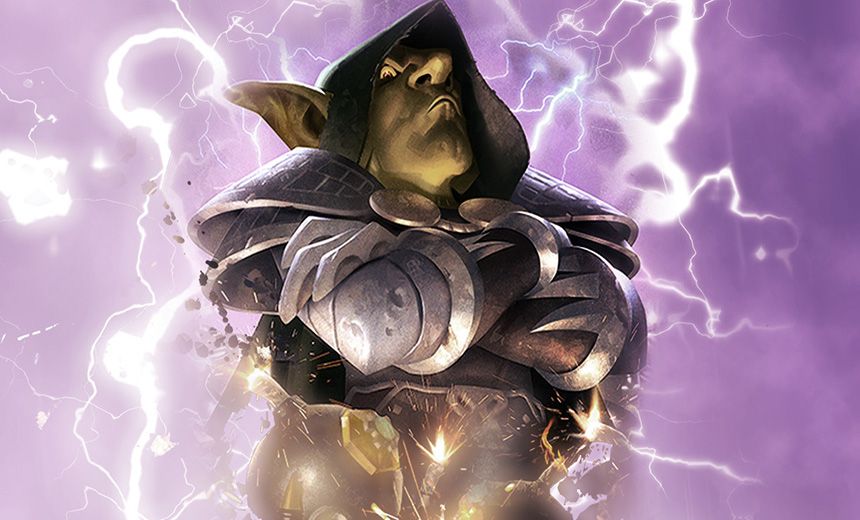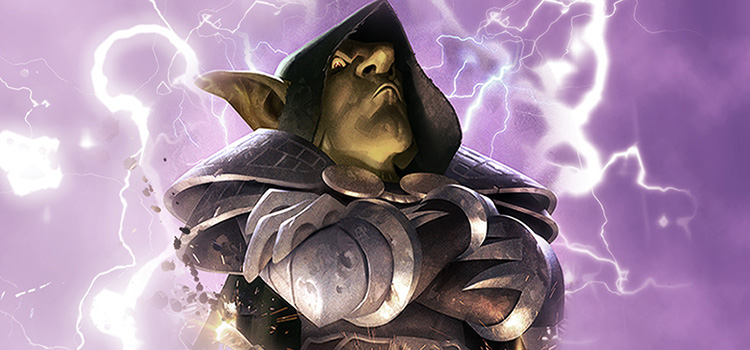
Image by: Expl0ud
"The Weekly Top" is a new series of features by GosuGamers to be published every Saturday.
Do not be fooled by Hearthstone’s young age. Blizzard’s game has been through a lot in its 2-year lifespan. It’s seen incredibly overpowered decks, broken cards, rapid metagame shifts and, of course, periods of solid, balanced and enjoyable experience.
Each part of Hearthstone’s development has been closely associated with one or two block or metagame-defining cards. Those dictated how the game was played by creating powerhouse decks or giving new life to previously unused classes. In this article, we examine some of the most prominent of said cards. Please note that this is the list of just one particular author. Feel free to agree and disagree with him in the comments.
Honorable mentions
[card]Muster for Battle[/card] – The only reason why Paladin is seen every once in a while. Introduced with GvG, Muster for Battle gave Paladins that early game presence card and [card]Knife Juggler[/card] synergy they always lacked.
[card]Tinker's Sharpsword Oil[/card] – The Oil came as the savior of Rogue after [card]Leeroy Jenkins[/card] and [card]Gadgetzan Auctioneer[/card] were nerfed, and with them the explosive burst of the Miracle Rogue.
[card]Sludge Belcher[/card] – One of Curse of Naxxramas' holy trinity together with [card]Loatheb[/card] and [card]Undertaker[/card], Sludge Belcher gave control decks a much needed persistent defense mechanism, and was almost singlehandedly the reason for the brief resurgence of Priest and Paladin in the days after the release.
[card]Nat Pagle[/card] and [card]Tinkmaster Overspark[/card] - This pair of cards was the first real example of why uncontrollable RNG is bad for the game, as they decided the game for the player who was being more lucky that day.
10. Blood Imp
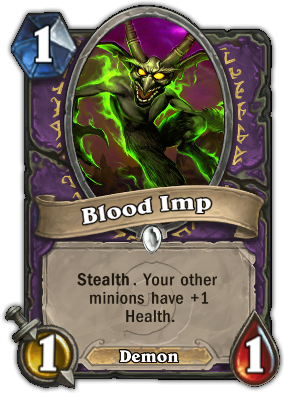 I know, I know, you’re wondering what [card]Blood Imp[/card] is doing here, that card hasn’t been seen in ages. In fact, many of our readers who weren't with Hearthstone from the start might not have ever encountered it in a game.
I know, I know, you’re wondering what [card]Blood Imp[/card] is doing here, that card hasn’t been seen in ages. In fact, many of our readers who weren't with Hearthstone from the start might not have ever encountered it in a game.
But years ago, Blood Imp was the scariest minion you could see coming from a Warlock. A stealthed nuisance, it buffed the health of your entire board and you couldn’t do anything about it. In times where Zoo was making its first steps, pioneered by Curi and Reynad, it was also at the same time the most deadliest. If you think [card]Nerubian Egg[/card] and [card]Haunted Creeper[/card] are difficult to kill as they are, imagine the entire Zoo board having +2 health.
Blood Imp, together with other powerful and later nerfed cards like [card]Shattered Sun Cleric[/card], [card]Dark Iron Dwarf[/card] and [card]Defender of Argus[/card] made Zoo the most dominant deck of its time. Zoo would later undergo periods of highs and lows before [card]Imp Gang Boss[/card] would return it to its previous dominant state.
9. Mountain and Molten Giant
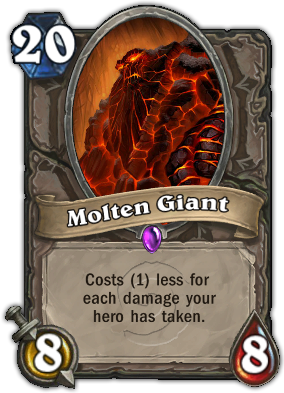 When I go back to the earliest days of Hearthstone and think of the most innovative deck I’ve seen, that would be Handlock. I am not going to play detective and search for the very first person who saw a connection between the Giants and Warlock’s hero power, but whoever that is – know that you’re fondly remembered.
When I go back to the earliest days of Hearthstone and think of the most innovative deck I’ve seen, that would be Handlock. I am not going to play detective and search for the very first person who saw a connection between the Giants and Warlock’s hero power, but whoever that is – know that you’re fondly remembered.
The defining parts of Handlock remain, of course, [card]Mountain Giant[/card] and [card]Molten Giant[/card], two of the absolute most powerful cards in Hearthstone. Despite their ridiculous mana costs, Handlock players could easily cheapen them by repeated Life Taps and drop Mountain Giants as early as Turn 4 and make Molten Giants be 8/8’s for 0 mana.
It sounds powerful, and it is, but that power came with a cost. As the state of many metagames were shaped by the mere presence of Handlock, players took it to themselves to find a counter and the Giants are the sole reason why [card]Big Game Hunter[/card] became popular.
But the monstrous duo was never limited to just Handlock. Talented deckbuilders found ways to weave them in Warrior OTK decks, Freeze and Echo Mages as well as Giants Paladins. I honestly can’t remember a pair of cards which have witnessed so many patches and expansions, yet never experienced a nerf or left the meta.
8. Savage Roar
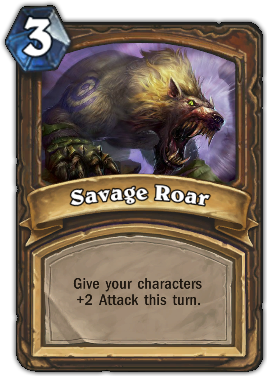 Savage Roar is usually tightly associated with [card]Force of Nature[/card] and with good reason. Initially discovered by Kitkatz and later passed on to Druid god StrifeCro, the two-card combo still remains the go-to finisher for the Druid class. It was a revolution in how the class was played and years later, Druid hasn’t gotten anything better.
Savage Roar is usually tightly associated with [card]Force of Nature[/card] and with good reason. Initially discovered by Kitkatz and later passed on to Druid god StrifeCro, the two-card combo still remains the go-to finisher for the Druid class. It was a revolution in how the class was played and years later, Druid hasn’t gotten anything better.
So why Savage Roar and not Force of Nature? For a couple of reasons. First of all, Savage Roar is the bigger damage boost, and provides 8 of the 14 points of damage in the combo. It’s also more versatile, being usable as early as T3 to remove dangerous early game threats.
Furthermore, Savage Roar was a centerpiece in the once popular Token Druids. Those builds relied on generating 1/1 minions through [card]Violet Teacher[/card] which could then be buffed through [card]Savage Roar[/card] for a lethal swing around T6, sometimes even quicker. In his article, my colleague Sumadin labeled it one of the most problematic cards for Hearthstone’s future. I don’t know if problematic is a word I’d myself use, but I know for sure that Savage Roar and the ramp spells are what has always kept Druid in the metagame.
7. Mechwarper
 Mana cost reduction cards have long proved to be incredibly powerful, not just in Hearthstone but in other TCG's as well. So when Magic: The Gathering veterans who remembered the terror of the Affinity metagame first saw [card]Mechwarper[/card] in the GvG spoilers, they immediately pointed to it as a potential block defining card.
Mana cost reduction cards have long proved to be incredibly powerful, not just in Hearthstone but in other TCG's as well. So when Magic: The Gathering veterans who remembered the terror of the Affinity metagame first saw [card]Mechwarper[/card] in the GvG spoilers, they immediately pointed to it as a potential block defining card.
They were right. Mechwarper's powerful effect made the numerous mech decks possible, creating the only tribal deck to last and be dominant for months on end. Mage rose to new levels of domination as it could spew multiple minions and protect them with burn spells. Shamans also revelled in the power of metal, discovering a new way to build and play.
Nowadays, Mech Mage is almost extinct but Mech Shaman pretty much became the standard Shaman build. While the reign of the mech tribal seems to be mostly overcome, one should not forget the numerous posts on reddit stating that "Mech Mage is the new cancer".
6. Gadgetzan Auctioneer
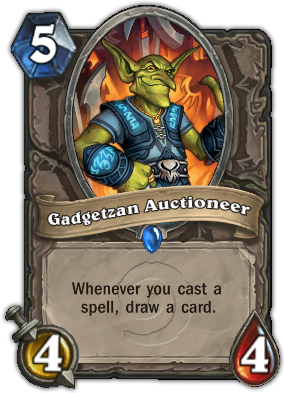 In the Honorable Mentions section, I talked about [card]Muster for Battle[/card] as the savior of the Paladin class. [card]Gadgetzan Auctioneer[/card] did the same but for Rogue. Only, it took it to levels of domination Paladin never achieved.
In the Honorable Mentions section, I talked about [card]Muster for Battle[/card] as the savior of the Paladin class. [card]Gadgetzan Auctioneer[/card] did the same but for Rogue. Only, it took it to levels of domination Paladin never achieved.
Suffering a nerf to many of its key cards during alpha, Rogue became a mid-tier class at best and it was a complete rebirth for the class when Gadgetzan made it to Rogue decks. Called “Miracle” for the large amount of cards it would draw on one turn, this new iteration of Valeera became the first combo deck that stuck and wasn’t immediately shot down with the nerf gun, like the Warrior and Hunter OTK decks were. Many Hearthstone streamers and competitors forged their legends mastering Miracle, including names such as Kolento, Rdu, Forsen, Realz and Hyped.
Although Gadgetzan made the biggest impact in Rogue decks, other classes too tried to make use of it. Miracle Shamans and Miracle Druids also fancied turning their cheap spells into card draw followed by inevitable OTK. And while those decks never stuck, Miracle Rogue did and dictated the metagame for months on end.
5. Dr. Boom
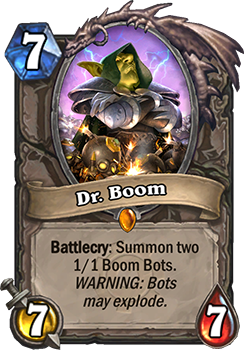 There are two types of cards that shape metagames. On one side, there are the broken, overpowered cards, those against which there is no effective counter-measure. They become the defining card of the block. On the other side are those who create a sort of a rippled effect, leading to a succession of metagame changes.
There are two types of cards that shape metagames. On one side, there are the broken, overpowered cards, those against which there is no effective counter-measure. They become the defining card of the block. On the other side are those who create a sort of a rippled effect, leading to a succession of metagame changes.
That’s what Dr. Boom did. Initially dismissed as a poor card as nobody knew the effect of the Boombots, [card]Dr Boom[/card] quickly became an auto-include finisher in every deck but the fastest aggro and midrange decks. Despite the outcry it caused, many do not perceive it as necessarily broken, but it did spawn a big wave of reaction.
As Dr. Boom was literally everywhere, players turned to the most logical counter – [card]Big Game Hunter[/card]. Like Boom, the dwarf became an auto-include in most decks, sometimes even two-of, which then caused further changes to the metagame. Players stopped using big minions, afraid of getting BGH’d. Decks were tailored to be BGH-safe and many mighty cards, which would be otherwise at least considered as finishers, were left on the bench. The metagame quickened. The few control decks had to find alternative ways to victory. Handlocks diminished, as Zoo and Malylock grew in power.
And it all spawned from one card which desperately needed an answer.
4. Unleash the Hounds
We’re getting into that area where cards become really powerful and, consequently, really hated. We start here – Unleash the Hounds.
Unleash the Hounds was likely the first, original broken card of Hearthstone that needed several iterations before it got balanced and fair. Its first version gave all friendly beasts +1/+1 and charge which spawned an OTK Hunter deck which would kill as early as T7 through a swarm of 1-mana beasts, drawn through [card]Starving Buzzard[/card].
Even when UtH was reworked to its current spawn-a-beast mode, things didn’t get better. In fact, they got worse. At (4) mana, the card was absolutely useless and it practically made Hunter the worst possible class. One month later, its mana cost got cut in half and Hunter swung in the other opposite. Starving Buzzard and/or [card]Knife Juggler[/card] were used together with UtH to generate board or card advantage, sometimes even both. Classes which relied on board population like Paladin and Shaman got extinct. Players would have to play with minimal number of minions or perish. The threat of UtH alone changed the way Hearthstone was played.
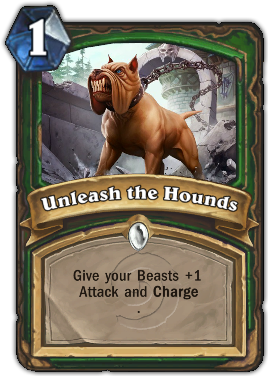
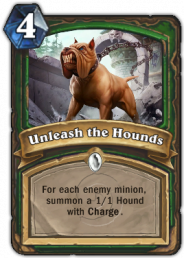
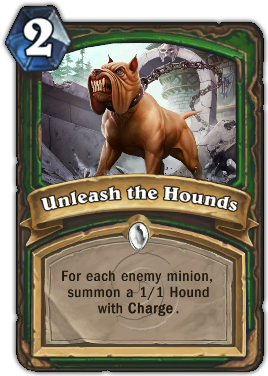
3. Leeroy Jenkins
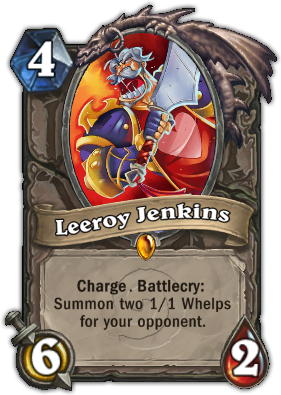 “Nobody is safe” is the perfect slogan for Leeroy Jenkins. Or was, when the card costed 4 mana and was seen in every deck.
“Nobody is safe” is the perfect slogan for Leeroy Jenkins. Or was, when the card costed 4 mana and was seen in every deck.
That’s not an overstatement. Aggro decks loved Leeroy because it was a natural choice for a finisher, but then again 6 damage out of nowhere fits pretty much everywhere. Warlocks used the card with [card]Power Overwhelming[/card] or [card]Shadowflame[/card] to clear the board or kill their opponents. Miracle Rogues would draw their entire decks to find Leeroy and two copies of [card]Shadowstep[/card]. Even slow Control Warriors would consider the card as an alternative finisher, a tech that was used a lot by the innovative TidesofTime.
Nobody was safe indeed.
2. Grim Patron
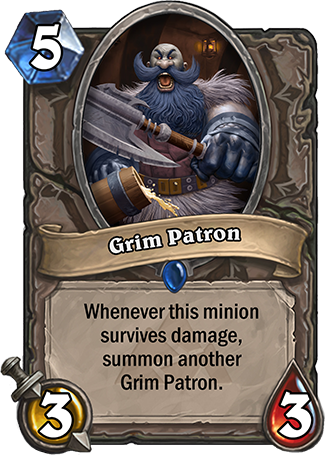 Finally, we arrive at the card that’s defining the current metagame at the time of this article. [card]Grim Patron[/card], originally dismissed as “not very good” by players and streamers has become the minion at the core of this block’s best deck.
Finally, we arrive at the card that’s defining the current metagame at the time of this article. [card]Grim Patron[/card], originally dismissed as “not very good” by players and streamers has become the minion at the core of this block’s best deck.
There’s inherent beauty in Grim Patron. The card is not only cool but its dominance also did not happen overnight. Only towards the end of the Blackrock Mountain roll-out did players start to experiment with it. When the synergies were discovered, it took numerous iterations and trials and errors before optimal builds could be found. Nowadays, it’s one of the most difficult decks to pilot and the tiniest miscalculation can lead to a game loss.
Grim Patron made combo decks what they should be - powerful but demanding, solid but counterable. Not to mention, Warriors now have a new toy to play with.
1. Undertaker
 It couldn’t have been any other card on the top. In all my two years of watching, playing and covering Hearthstone, I’ve never encountered a card that shaped and dominated a metagame as Undertaker did.
It couldn’t have been any other card on the top. In all my two years of watching, playing and covering Hearthstone, I’ve never encountered a card that shaped and dominated a metagame as Undertaker did.
Introduced with Curse of Naxxramas, [card]Undertaker[/card] emerged as the ultimate early game card. Able to grow big very quickly, it was employed by virtually every proactive deck, from Hunter, to Mage and even Priest. It had no intuitive counter besides a timely [card]Ironbeak Owl[/card]. It was the definition of snowball if there ever was one. Oftentimes, a single [card]Undertaker[/card] would decide the game as early as T3. A coined-out double [card]Undertaker[/card] would force an auto-concede.
While Grim Patron demonstrates what a good block-defining card is, Undertaker was the exact opposite. It was not fun, it was not difficult to play, it fit many decks and it singlehandedly decided games before their time.
Do you agree with our list? Would you add, take away or change something? Let us know in the comments.

